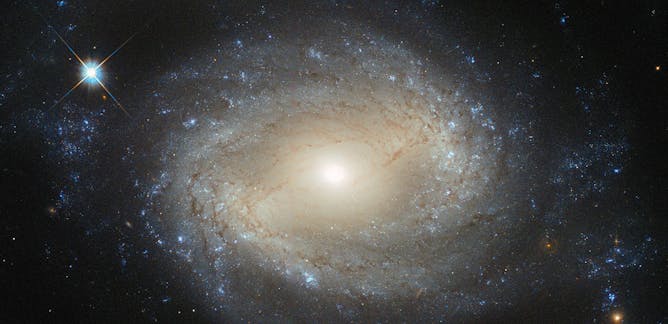
JAMIE BARRETT
In 1924, Edwin Hubble discovered stars that lie outside our own galaxy. This sparked new interest in astronomers, who since then have directed their telescopes past nearby stars and out towards much more distant objects. Many cosmological marvels have been found, such as the blue giant Icarus, which was identified in 2016 in a spiral galaxy around 5 billion light years away from Earth. However, despite nearly a century of discoveries, the process by which galaxies form is still missing many details.
All science relies on data, and to understand the origins of galaxies, we need to study early galaxies. This may seem impossible, but the nature of light provides a helping hand. The speed of light means that the time taken to travel distances on a human scale may be negligible, but on a large scale, a single photon may take many hundreds or millions of years to travel through a galaxy, and even longer to reach us, carrying the same information as when the photons was first emitted.
When we detect these photons, we see the information from however many millions of years ago, even though what we are looking at may have changed since then. The further the light has to travel, the older the information is. This means that in order to study earlier galaxies, we need to study distant galaxies. But things that are far away are also very small, and building or hiring telescopes with the necessary resolution is very costly.
The James Webb Space Telescope (JWST) is one current project which will help answer these questions, and is planned to launch in the coming years. Using data collected by the JWST, scientists will be able to analyse more detailed data from distant galaxies and compare features like their mass, brightness, rotation speed, and chemical composition with closer, older galaxies. Additionally, existing telescopes can be upgraded or repurposed to help with this investigation.
Most of these efforts focus on collecting more data, but since this is expensive - the JWST alone cost close to $10 billion - knowing what to search for and what data to collect is vital. Until powerful telescopes were constructed, cosmologists have largely relied on information about nearby galaxies, which are much cheaper to observe in detail. The development of the science of galaxies has also shaped our understanding of the cosmos as a whole.
We now know that most galaxies are centred around an enormous black hole, and it is clear that black holes are involved in galaxy formation, but more data is needed to clarify how they factor in. We have also found that galaxies can be categorised into a number of distinct shapes, such as spiral and elliptical, but we don’t yet know for certain the conditions that lead to these forms. We have uncovered evidence that some galaxies have been involved in merging with others, but there still is much to learn about the effects of these collisions.
Studying galaxies can help us answer more fundamental questions as well. It was by doing such research that dark matter was first postulated, so the effect it has on galaxy formation may provide insights into its nature. The rate at which the universe expands takes different values depending on how it is measured, so knowing the distribution of dark matter within the universe with more accuracy will inform models that may solve this issue. If understanding how early galaxies work tells us more about black holes, in which gravity has an effect on subatomic scales, that could revolutionise attempts to unify quantum physics and general relativity.
The launch of the JWST should give us valuable data which may shape many aspects of fundamental physics, from the role black holes play and how the shape of galaxies evolves over time to the nature of dark matter and the unification of two contrasting fields. Despite the initial cost, there is much to be gained from looking into the unknown.
Bibliography
Space (2019). Galaxies: Collisions, Types, and How They’re Made. Available at: https://www.space.com/15680-galaxies.html (Accessed: 11 June 2020)
NASA JWST (n.d.). Assembly of Galaxies. Available at: https://www.jwst.nasa.gov/content/science/galaxies.html (Accessed: 11 June 2020)
NASA (2018). Hubble Uncovers The Farthest Star Ever Seen. Available at: https://www.nasa.gov/feature/goddard/2018/hubble-uncovers-the-farthest-star-ever-seen (Accessed: 11 June 2020)
Many thanks to June B. for her assistance with researching and reviewing the science used in this article.
Comments
Post a Comment